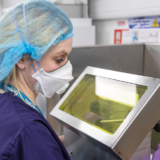A real-world case study to set the scene
Timothy Omer is a Type 1 diabetic and a ‘health hacker’. He, and other patients affected by this debilitating condition, have banded together under the #WeAreNotWaiting banner to develop their own solutions to their health issues.
They have lost patience with an industry apparently failing to find answers to the mental pressures of keeping track of their blood sugar levels, treatments, and medication calculations, leading them to exhaustion. They have, metaphorically, taken the ‘law’ into their own hands.
To date, they have cracked a number of complex technical challenges that had not been addressed, with active plans in place to tackle more.
Admittedly, developing medicines is an order of magnitude more challenging than issues of a digital nature; but could a similar degree of passion lead to patient groups seeking out smaller, more focussed companies, and smarter working methods, offering them greater control over their own medical destinies?
What would need to happen first to kick start such a revolution?
We need to revisit a long standing industry myth to find out.
Time to rebuff the myth that drugs are discovered by accident
There is a myth in the industry that drugs are discovered accidently by scientists working deep in the bowels of a laboratory.
The myth can be traced back to 1928, when Alexander Fleming is reported to have discovered penicillin. In fact, what he actually ‘found’ was strong evidence that a mould in one of his agar plates contained an ingredient active against bacteria, but he had no idea what it was.
It was not until 1939 that a team from Oxford University isolated the active ingredient and made enough to run pre-clinical and clinical studies. By now the evidence for safety and efficacy was incredibly strong, but they did not know how to take that crucial step – making enough to satisfy the patient population.
That originated from a mould manufacturing expert at the predecessor to the US FDA (USDA), Andrew J Moyer, who devised a process to produce penicillin in the requisite huge quantities. And none of this was an accident – it was a model of stakeholder collaboration, across government, regulators, drug developers, and academia; together of course, with patients and doctors. They worked hand in glove in the fight against infection under the ravages of the Second World War.
So, why did the world believe penicillin was found by accident? Fleming spoke to The Times about his original discovery, but none of the others involved did; and so the myth endured, even to this day.
If drugs aren’t discovered by accident, how should they be?
The clue is in the case study. Until a patient is successfully dosed with a compound from the full scale manufacturing process, nothing has been achieved, albeit a massive amount of intellectual and scientific rigour may have gone into things.
If A J Moyer had not been around in the early 1940s, penicillin would never have seen the light of day (note: Moyer was inducted into the National Inventors Hall of Fame in 1987).
There is another surprising aspect to this. What if Oxford University and USDA had been involved at the time Fleming made his discovery? Bringing their specialist skills to bear in the design of the development programme; and how much more quickly could Fleming have made his ‘accidental’ discovery if he had access to the ex vivo predictive technologies there are available today?
In fact, why don’t we take a leaf out of penicillin’s book and design drugs the exact same way?
Designing drugs the penicillin way
These would be the guiding principles:
- Prevention first, the main focus for Healthcare Professionals (HCPs).
- Disease considered holistically, diagnosis and therapy go hand-in-hand.
- If medicine is required, deep engagement of HCPs and patients at the start.
- Involve more stakeholders at concept stage.
- Include payers, commercial manufacturing, suppliers, patient groups and charities.
- Lower barriers to entry for smaller drug developers with simplification and standardisation.
- Prototype compounds (ex vivo) to cut attrition rates and minimise testing in animals.
- Early and strategic planning of supply chain, optimising quality, cost and speed to market.
- Engage meaningfully with regulatory bodies every step of the way.
Where do patients fit in?
Armed with the above principles, patient groups suffering the terrible effects of a particular disease would be able to drive their own collaboration agenda. Who is more incentivised to bring a drug to market than those patients themselves? They just need to be empowered with knowledge of the who, what, where and when of drug development, we don’t need to ask the why.
Is now the time to re-define the drug discovery and development paradigm, so like Tim Omer and friends, #WeAreNotWaiting becomes the guiding mantra for patients worldwide?
About the author
Hedley Rees is a zealous advocate of modernization in the Pharma and Biotech sectors, as well as being Managing Consultant at PharmaFlow, a UK based consultancy specializing in socio-technical systems improvement within life sciences.
He is author of “Supply Chain Management in the Drug Industry: Delivering Patient Value for Pharmaceuticals and Biologics” published by J Wiley, NJ 2011 and “Find It, File It, Flog It“, released by Wordcatcher Publishing in 2017.
This article is from a series contributed by the UK drug discovery community. For more information read our disclaimer.




